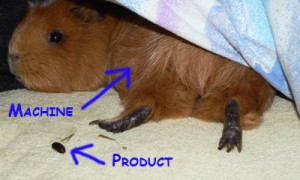The machine converts various plant materials into semi-dry pellets. It’s self-propelled, runs on eco fuel exclusively and it is easy to activate by placing raw material anywhere within its reach and wait for the impressive array of sensors to point it the right way. The input material is taken up at the front end, broken down into smaller bits and finely ground. The machine then proceeds to process the resulting pulp by extracting fluids and compressing the remaining material into pellets which are ejected from its rear end.
The pellets are of two types: the hard pellet that is considered the final product and as such ignored by the machine, and the soft pellet that is picked up by the machine almost instantly and dutifully recycled. The previously-extracted fluid is excreted at the rear too, usually at the lowest point of the plane accessible to the machine, and if it happens to be a soft surface you’re either standing or sitting upon, the fluid will be deposited right where your foot or your butt, respectively, is parked.
The machine’s sensory array deserves a closer look. Quite amazingly, the Cavia-P pellet press is capable of visual, olfactory and auditory location of input material, the latter being of special interest as it is subject to considerable self-programming. The machine will quickly learn to identify auditory signals associated with potential raw input material, like the rustling of bags, opening of a fridge door, running water in the kitchen sink, the sound of the knife against the cutting board etc. Upon detecting an upcoming batch of input material, the machine, especially if idle, will emit a succession of rather intense whistles. The machine can be conditioned to whistle on your command through classical conditioning, e.g. by the operator repeating a short phrase each time a new batch of input material is presented to the machine.
Some operators report modest success with instrumental conditioning where the machine is provided with an especially appealing chunk of input material each time it executes a sequence of actions deemed desirable by the operator. I, for one, remain sceptical about the dynamics of instrumental conditioning in the Cavia-P model as I have noticed it quite likely works the other way around: the machine executes a simple manoeuvre, like lifting up its front end and balancing its weight on its pellet ejector for a second, and then the operator gets very excited and feeds the machine a special treat. In my opinion, the question of which entity is programming the other remains open for the time being.
It needs to be pointed out that the machine is constantly searching for potential input materials and therefore any items that, if transformed into pellets, might break your heart or damage the machine, must be kept in a safe place out of the machine’s reach. One of my machines once transformed my regular mouse into a wireless one when I wasn’t looking, so operators beware. Luckily the machine’s spring mechanism, though capable of propelling it over small obstacles, is not nearly powerful enough to enable it to ascend regular furniture. Any items left on the floor, though, will be investigated and tested for pelleting suitability. The machine invariably tests pelleting suitability of a newly encountered item by taking a chunk out of it.
These machines come equipped with another interesting function: they’re self-tidying. The instant they detect something out of the ordinary they will retreat to safety with lighting speed. Then they will periodically emit rumbling sounds until everything returns to normal and probably continue to do so for considerable time afterwards while refusing to resume pelleting operation.
Last but certainly not least, the Cavia-P model is available in two versions: with male or female posterior attachment. The two versions should either be kept separated or, if they are to be operated together, the attachments must be disabled by a properly qualified specialist. Failure to do so will result in the machines interlocking their attachments and weird things happening. Take it from somebody who once brought a female attachment version from a shop where all the machines were kept in the same enclosure and was surprised to discover the newly-bought machine ejected two smaller ones from its business end one Tuesday morning. I called the shop and sarcastically inquired whether they expected me to pay extra for the two mini machines that were pre-packaged in the one I bought.
Strong words had been exchanged and I have been operating the two extra machines and shaming the irresponsible store management ever since.
Type: Pellet press
Model: Cavia-P
